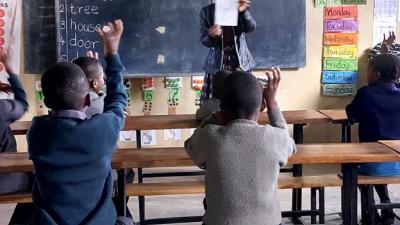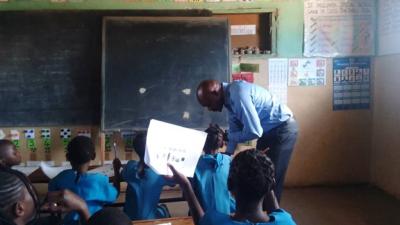Research shows: Dutch method proves effective in Zambian context for teaching children who are deaf to read
Research in Zambia reveals that the reading methodology used by Kentalis International in its African partner countries is successful in helping young children who are deaf learn to read. The study shows a significant impact: word decoding improved nearly twice as much among students who used the method, and their sign vocabulary increased by an impressive 4.5 times.
Early literacy development is crucial for the academic success of students who are deaf. At the same time, learning to read is one of the biggest challenges in deaf education worldwide. Children whose first language is sign language – a visual language – must learn to read in a second language: the spoken language. The sentence structure of both languages differs greatly, making reading sentences especially difficult for beginning readers. The ‘Reading Method for Early Literacy’ (RMEL) addresses this challenge. It is a reading methodology developed by Kentalis International Foundation and used in its knowledge exchange projects in African countries. The method is based on scientific research and the daily practice of Royal Kentalis, the Dutch parent organization of Kentalis International Foundation.
Kentalis International Foundation adapted the reading methodology from its Dutch colleagues to the local African context and implemented it in teacher training programs in various countries – in English, French, and Swahili. In 2025, researchers in Zambia studied the effectiveness of RMEL.
The challenge of learning to read for deaf and hard-of-hearing children
Literacy development in children who are deaf differs from that of hearing children. Unlike children with typical hearing, many children who are deaf start grade 1 with a limited language foundation. This is largely because children who are deaf have sign language as their first language. If they do not receive sufficient exposure to sign language at home, they begin school already at a disadvantage. To effectively teach children who are deaf to read, it is essential that teachers have access to specialized, research-based methods.
This is often lacking in Zambia, a country where Kentalis International Foundation has been active for years. Here, students who are deaf face major challenges in developing reading and writing skills due to insufficient support in language and communication. This leads to lagging academic performance. That’s why Kentalis International Foundation runs projects to transfer the RMEL to teacher trainers (instructors at teacher training colleges), ensuring the knowledge reaches the right classrooms.
The Reading Method for Early Literacy by Kentalis International Foundation
The RMEL is a reading method specifically designed for deaf children and is based on the reading methodologies of Royal Kentalis in the Netherlands. This method assumes that students who are deaf learn best through reading strategies tailored to their way of communicating. The approach consists of four steps:
- Teaching signs
- Using stories in sign language
- Learning written words using fingerspelling
- Reading short sentences or stories
In addition to these steps, other strategies are employed, such as visual and sensory activities, and interactive games that allow teachers to monitor student progress. These active, expressive learning methods help students improve their language and reading skills.
A key component of the method is the use of semantic networks and visualization. This helps students better understand and remember new words. This is done through structured lessons, practice games, and direct instruction.
The RMEL takes into account the different ways that children who are deaf communicate. This approach enables them to develop better language and reading skills, forming a strong foundation for their further academic journey.

Research: How effective is this method?
Although the various elements of the reading methodology have been developed and studied in the Netherlands, Kentalis International Foundation wanted to know how well the method – after contextualization – actually met the needs of teachers in different African countries. That’s why local researchers in Zambia focused on this question.
Methodology
The study in Zambia involved 60 students who are deaf in grade 1 at schools in the Southern Province and Copperbelt Province. Their average age was 11 years. The students were divided into two groups:
- The experimental group (45 students) received lessons using RMEL.
- The control group (15 students) followed the regular, existing curriculum.
To measure the effect of the RMEL, two tests were administered at different times: a vocabulary test and a decoding test (for recognizing and deciphering words). These test results were quantitatively measured and compared.
Additionally, 30 participating teachers completed questionnaires sharing their experiences.
Results
The study took place over one school year. Students from both the experimental and control groups were evaluated at two points:
- Phase 1: after 6 months of instruction
- Phase 2: after 12 months of instruction
At both points, students took the same tests: a vocabulary test and a word decoding test, allowing their progress to be tracked accurately.
Results of the vocabulary test
The vocabulary test measured the students’ sign language vocabulary. In phase 1, the experimental group scored an average of 9.4 points, while the control group scored 7.4. In phase 2, the experimental group scored 15.8 (+6.4), compared to 8.7 (+1.3) in the control group. This shows approximately 4.5 times greater progress in the experimental group compared to the control group.
Table 1: Descriptive statistics for the vocabulary test
| Phase 1 | Phase 2 | ||||
| N | M | SD | N | M | SD |
Experimental | 42 | 9.38 | 2.97 | 45 | 15.82 | 3,46 |
Control | 13 | 7.38 | 1.89 | 15 | 8.73 | 3,49 |
Graph 1: Average score vocabulary test
Results of the word decoding test
Word decoding is the process by which a reader converts written words into sounds (for hearing children) or sign meanings (for deaf children), by correctly recognizing letters and letter combinations and linking them to meaning. Since pronunciation is not applicable for students who are deaf, they were asked to cross out the incorrect (non-existent) word from a list of written words, to assess whether they could successfully decode the correct words.
In phase 1, the experimental group scored an average of 3.0 points, while the control group scored 1.9. In phase 2, the experimental group scored 5.5 points (+2.5), compared to 3.2 (+1.3) points in the control group. This shows approximately twice as much progress in the experimental group compared to the control group.
Table 2: Descriptive statistics for the word decoding test
| Phase 1 | Phase 2 | ||||
| N | M | SD | N | M | SD |
Experimental | 45 | 3.04 | 1.73 | 43 | 5.53 | 1.98 |
Control | 15 | 1.87 | 1.36 | 15 | 3.15 | 1.86 |
Graph 2: Average score on the word decoding test
Results from teacher questionnaires
The teacher questionnaires show that the majority are positive about the RMEL. Of the 30 teachers surveyed, 16 rated the method as “good” and 9 as “very good.” Only 5 teachers considered the method “fair.” This means that 25 out of 30 teachers recommend RMEL for teaching students who are deaf.
The method is also perceived as user-friendly. According to the teachers, RMEL helps students better understand the material by using visual support such as signs, fingerspelling, and images. This approach makes it easier for students to learn new words and grasp concepts—even for those who struggle more with learning.
All 30 teachers recommend broader implementation of RMEL in Zambian schools. They report that the method helps achieve learning goals, enables students to learn faster, and is motivating. Furthermore, the study shows that 28 out of 30 teachers express a need for further training in using RMEL. They want to deepen their knowledge, improve their teaching skills, and stay updated on new insights. This desire for continued professional development highlights the enthusiasm and commitment of teachers to improving reading education for students who are deaf.
Conclusion and Recommendations
The RMEL has had a clearly positive effect on key foundational reading skills, such as vocabulary acquisition and decoding written words among students who are deaf. The RMEL group showed a vocabulary improvement that was 4.5 times greater than that of the control group. For word decoding, the progress was nearly twice as large as in the control group.
Although this study did not evaluate aspects such as reading fluency and comprehension of sentences or stories, the strong results in vocabulary and word decoding suggest that RMEL effectively supports the development of early literacy. The method creates a visually rich and language-stimulating learning environment, which is essential for deaf students.
Teachers who worked with RMEL were enthusiastic about the approach. They reported that the method helps achieve learning goals, that students grasp concepts more quickly, and that the use of visual tools such as fingerspelling, signs, and images enhances the learning process.
The study recommends broader training for teachers in Zambia in the use of RMEL within special education for learners who are deaf. Since the study covered only one school year and the control group was relatively small, follow-up research over a longer period is desirable.
It is also recommended to measure reading fluency and text comprehension alongside vocabulary and word decoding, to gain a more complete picture of RMEL’s impact on reading skills.
Kentalis International’s work aligns with the recommendations to expand the use of RMEL in Zambia. The methodology is currently being approved by the Zambian Ministry of Education, which is incorporating RMEL into its professional development program for special education teachers. As a result, many teachers in Zambia will be introduced to the method and learn how to apply it in their classroom practice.
About Kentalis International Foundation
Kentalis International Foundation is a non-profit organization that shares the expertise of its Dutch parent organization, Royal Kentalis, through international projects in countries where such expertise is less available – focusing particularly on the African continent. Through this work, Royal Kentalis contributes to the Convention on the Rights of People with Disabilities (CRPD), which the Netherlands has signed.
Read more about who we are.
Interested to learn more about the research done in Zambia? Download the full research report.
